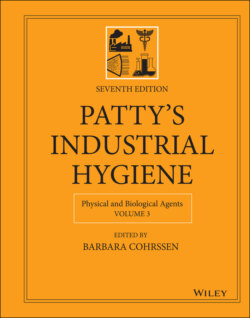Читать книгу Patty's Industrial Hygiene, Physical and Biological Agents - Группа авторов - Страница 130
5.2.2 Distance from Source
ОглавлениеWhen the source directly irradiates a worker, increasing the distance of the worker from the source is an effective control measure for optical radiation hazards generally.
UV hazards and IR hazards to the cornea and lens, as well as the blue‐light hazard for small sources subtending less than 0.011 rad, depend on the irradiance received at the eye. If the distance from a source is more than five times the longest dimension of the source, the irradiance received at the surface of the skin or cornea decreases inversely with the square of the distance from source, as stated in Eq. (23). If the exposure geometry does not meet the “five times” rule, the irradiance decreases less rapidly with distance. For example, for a uniform line source of length l and radiant power Φ, the irradiance at a distance r is given by
(27)
where α is the angle in radians subtended by the source. The angle subtended by a source of length l when its midline is viewed straight on from a distance r is
(28)
For retinal thermal hazards, the maximum allowable thermal‐hazard‐weighted radiance is inversely proportional to the angular subtense of the source (Eq. (16)). Increasing the distance from the source reduces the angular subtense, potentially increasing the allowable limit for the retinal‐thermal‐hazard‐weighted radiance.
The allowable limit for the blue‐light hazard for sources subtending an angle greater than 0.011 rad is a blue‐light‐weighted radiance of 100 J cm−2 sr−1. This limit is not altered by changing the distance from the source unless the change reduces the angular subtense of the source below 0.011 rad. The size of the area on the retina affected by an overexposure would, however, be reduced if the angular subtense were reduced by any amount. Increasing the viewing distance r from an excessive blue‐light source could, therefore, limit the areal extent of potential damage to the retina, even if the risk of incurring some photochemical damage remained unchanged.
